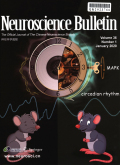- 钛学术文献服务平台 \
- 学术期刊 \
- 医药卫生期刊 \
- 神经病学与精神病学期刊 \
- 神经科学通报(英文版)期刊 \
An Automatic HFO Detection Method Combining Visual Inspection Features with Multi-Domain Features
An Automatic HFO Detection Method Combining Visual Inspection Features with Multi-Domain Features
基本信息来源于合作网站,原文需代理用户跳转至来源网站获取
摘要:
As an important promising biomarker,high frequency oscillations (HFOs) can be used to track epileptic activity and localize epileptogenic zones.How-ever,visual marking of HFOs from a large amount of intracranial electroencephalogram (iEEG) data requires a great deal of time and effort from researchers,and is also very dependent on visual features and easily influenced by subjective factors.Therefore,we proposed an automatic epileptic HFO detection method based on visual features and non-intuitive multi-domain features.To eliminate the interference of continuous oscillatory activity in detected sporadic short HFO events,the iEEG signals adjacent to the detected events were set as the neighboring environ-mental range while the number of oscillations and the peak-valley differences were calculated as the environ-mental reference features.The proposed method was developed as a MatLab-based HFO detector to automati-cally detect HFOs in multi-channel,long-distance iEEG signals.The performance of our detector was evaluated on iEEG recordings from epileptic mice and patien(t)s with intractable epilepsy.More than 90% of the HFO events detected by this method were confirmed by experts,while the average missed-detection rate was < 10%.Compared with recent related research,the proposed method achieved a synchronous improvement of sensitivity and specificity,and a balance between low false-alarm rate and high detection rate.Detection results demonstrated that the proposed method performs well in sensitivity,specificity,and precision.As an auxiliary tool,our detector can greatly improve the efficiency of clinical experts in inspecting HFO events during the diagnosis and treatment of epilepsy.

推荐文章
Shadow–highlight feature matching automatic small crater recognition using high-resolution digital o
Moon
Crater recognition
Image processing
Space exploration
关于Domain半群与Domain半环
Domain半群
D-Clifford半群
Domain半环
A re-assessment of nickel-doping method in iron isotope analysis on rock samples using multi-collect
Fe isotope
Ni-doping
Stable isotope
Precision and accuracy
Mass bias correction
Pseudo-high mass resolution
内容分析
关键词云
关键词热度
相关文献总数
(/次)
(/年)
文献信息
| 篇名 | An Automatic HFO Detection Method Combining Visual Inspection Features with Multi-Domain Features | ||
| 来源期刊 | 神经科学通报(英文版) | 学科 | |
| 关键词 | |||
| 年,卷(期) | 2021,(6) | 所属期刊栏目 | Original Articles |
| 研究方向 | 页码范围 | 777-788 | |
| 页数 | 12页 | 分类号 | |
| 字数 | 语种 | 英文 | |
| DOI | |||
五维指标
引文网络
引文网络
二级参考文献 (56)
共引文献 (0)
参考文献 (29)
节点文献
引证文献 (0)
同被引文献 (0)
二级引证文献 (0)
1984(1)
- 参考文献(0)
- 二级参考文献(1)
1986(1)
- 参考文献(0)
- 二级参考文献(1)
1989(1)
- 参考文献(0)
- 二级参考文献(1)
1992(1)
- 参考文献(1)
- 二级参考文献(0)
1993(1)
- 参考文献(0)
- 二级参考文献(1)
1994(1)
- 参考文献(0)
- 二级参考文献(1)
1996(2)
- 参考文献(0)
- 二级参考文献(2)
1997(2)
- 参考文献(0)
- 二级参考文献(2)
1999(2)
- 参考文献(0)
- 二级参考文献(2)
2000(1)
- 参考文献(0)
- 二级参考文献(1)
2001(1)
- 参考文献(0)
- 二级参考文献(1)
2002(2)
- 参考文献(1)
- 二级参考文献(1)
2003(3)
- 参考文献(0)
- 二级参考文献(3)
2004(3)
- 参考文献(0)
- 二级参考文献(3)
2005(1)
- 参考文献(0)
- 二级参考文献(1)
2006(3)
- 参考文献(1)
- 二级参考文献(2)
2007(8)
- 参考文献(2)
- 二级参考文献(6)
2008(1)
- 参考文献(0)
- 二级参考文献(1)
2009(2)
- 参考文献(0)
- 二级参考文献(2)
2010(4)
- 参考文献(2)
- 二级参考文献(2)
2011(1)
- 参考文献(0)
- 二级参考文献(1)
2012(4)
- 参考文献(1)
- 二级参考文献(3)
2013(5)
- 参考文献(3)
- 二级参考文献(2)
2014(5)
- 参考文献(1)
- 二级参考文献(4)
2015(3)
- 参考文献(0)
- 二级参考文献(3)
2016(6)
- 参考文献(5)
- 二级参考文献(1)
2017(6)
- 参考文献(2)
- 二级参考文献(4)
2018(8)
- 参考文献(4)
- 二级参考文献(4)
2019(6)
- 参考文献(6)
- 二级参考文献(0)
2021(0)
- 参考文献(0)
- 二级参考文献(0)
- 引证文献(0)
- 二级引证文献(0)
引文网络交叉学科
相关学者/机构
期刊影响力
神经科学通报(英文版)
主办单位:
中国科学院上海生命科学研究院
出版周期:
双月刊
ISSN:
1673-7067
CN:
31-1975/R
开本:
16开
出版地:
上海市岳阳路319号31B楼405室
邮发代号:
4-608
创刊时间:
1985
语种:
eng
出版文献量(篇)
2003
总下载数(次)
1
总被引数(次)
9688
期刊文献
相关文献
推荐文献
- 期刊分类
- 期刊(年)
- 期刊(期)
- 期刊推荐
神经科学通报(英文版)2022
神经科学通报(英文版)2021
神经科学通报(英文版)2020
神经科学通报(英文版)2019
神经科学通报(英文版)2018
神经科学通报(英文版)2017
神经科学通报(英文版)2016
神经科学通报(英文版)2015
神经科学通报(英文版)2014
神经科学通报(英文版)2013
神经科学通报(英文版)2012
神经科学通报(英文版)2011
神经科学通报(英文版)2010
神经科学通报(英文版)2009
神经科学通报(英文版)2008
神经科学通报(英文版)2007
神经科学通报(英文版)2006
神经科学通报(英文版)2005
神经科学通报(英文版)2004
神经科学通报(英文版)2003
神经科学通报(英文版)2002
神经科学通报(英文版)2001
神经科学通报(英文版)2000
神经科学通报(英文版)2021年第8期
神经科学通报(英文版)2021年第7期
神经科学通报(英文版)2021年第6期
神经科学通报(英文版)2021年第5期
神经科学通报(英文版)2021年第4期
神经科学通报(英文版)2021年第3期
神经科学通报(英文版)2021年第2期
神经科学通报(英文版)2021年第12期
神经科学通报(英文版)2021年第11期
神经科学通报(英文版)2021年第1期

 免费查重
免费查重










